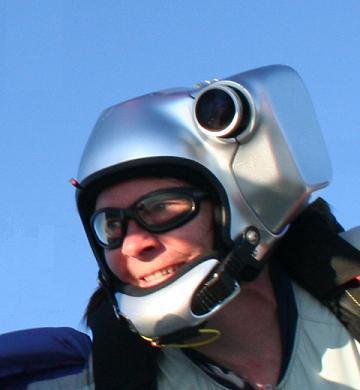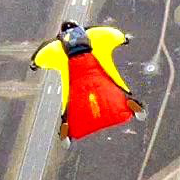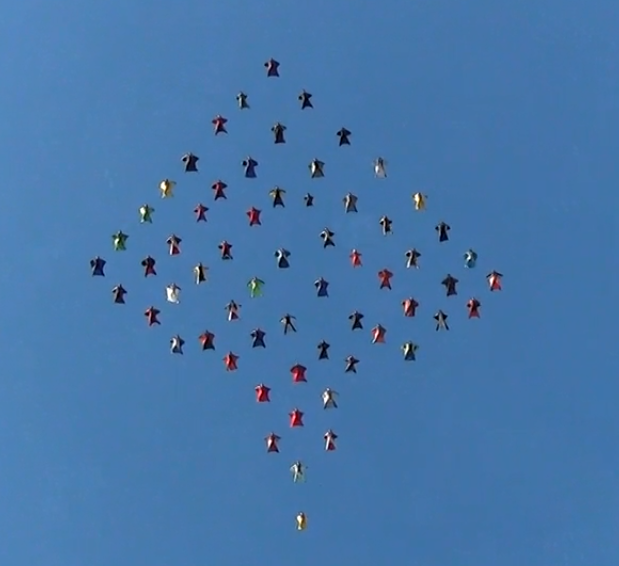Recommended Posts
mdrejhon 8
Has anyone had major problems doing sustained stalls on a Sabre (170 square feet, wingload 1.15) with safe recovery? It's something I'd like to try this year (at 4000-5000 feet), but I don't want to cause it to suddenly mal. I'd notify the dropzone of course, so they don't have a heart attack watching me.
QuoteI too am more interested in learing this manuever walt. Since I managed to almost do such a thing at 800 at it scared the shit out of me I'd like to know how to control such a feat. I believe I've actually seen video of a high performance canopy doing such a thing. I was like how in the hell is he turning backward. Pretty cool.
My worries are a mal with this maneuver. Do you have trouble keeping the lines from twisting? Would you recommend leaving the brakes set when learning so that you don't screw up and release one to rapidly due to panick. That is something I can see myself doing. Have not tried to stall my canopy with rears yet though, it isn't the easiest to stall with toggles. Spose with brakes set it might not be that hard. And trust me any such efforts will be done up high.
First of all, what kind of main are you jumping?
That makes a *huge* difference in the liklihood of inducing severe line twists.
Let me go over some general points.
First of all, on a moderately-to-lightly-loaded square (non-elliptical) canopy, stalls are standard maneuver. You are not doing anything that the canopy is not designed to do.
The basis for doing a stall turn is obviously a canopy stall. You can do it with either rear risers or toggles, but I much prefer toggles because they are quite easy and have a far greater control range than risers, giving you the ability to easily make very small control inputs.
If you are having difficulty in stalling your canopy, you may need to set your toggles higher. To take advantage of the full control range your canopy has, the toggles need to be at a location on the steering lines where they do not restrict the canopy from reaching full flight, but they *do* pull down part of the canopy's trailing edge as soon as you pull them. In other words, you need to make sure there is no "slack" in your steering lines when your toggles are in the full up position.
When in full flight under your canopy, look to see how much slack is in your steering lines. Take a felt-tip pen or some other device you can use to mark your lines. With the pen in one hand, pull one toggle gently with the other hand and mark the point on the steering line where it goes through the keeper ring when you have all slack taken out of the steering line, but the canopy is still in full flight.
Do this for both sides and double check the markings after you make them. Have your rigger re-locate the toggles. On the next jump, verify your canopy's control range by looking to make sure the trailing edge of your canopy is not pulled down when the toggles are in the full up position and then gently inducing a stall.
Stall your canopy by gently pulling your toggles down until the canopy drastically slows down. You will hear the "wind" noise get very quiet and feel your speed decrease. There is no mistaking when the stall occurs--your canopy will mostly deflate and start flying backwards. 9-cell canopies tend to take on a funny-looking horseshoe shape.
Reinflate your canopy by *gently* raising your steering toggles. Be aware that if your canopy inflates asymmetrically, which is very likely, you will get whipped around a bit but it is perfectly within the canopy's capability and your body's capability to handle it with no problem.
Do a few stalls, holding each one longer. During the longer stalls, you will very likely find the canopy turning. You can experiment with *tiny* toggle inputs to increase or decrease or even stop the turn. You can also shift around in your harness.
Stalls are fun, but it takes some getting used to. When you can comfortably stall and recover your canopy, you are ready to try a stall turn.
Stall your canopy and then raise one toggle very gently until that side of your canopy inflates and you start turning backwards. The turn can get quite fast depending on how high you raise the toggle. You can either lower the toggle to go back into a full stall or raise the other toggle to completely re-inflate the canopy.
After getting comfortable with stall turns, practice coming out of the turn in 90 degree increments. You should be easily able to do a 180, 270, or 360 degree stall turn by timing when you begin reinflation of the stalled side of your canopy.
As far as doing it with brakes set, I don't really recommend that until later when you want to try rear-riser stalls just for fun. Toggle stalls really are easier and more comfortable for square canopies. I have no experience stalling ellipticals, so I can make no recommendations there.
In my experience line twist is most likely to happen during rapid asymmetrical inflation of your canopy. When recovering from a stall, *slowly* and evenly raise the toggles. On my Triathlon 175 (I load it at about 1.2) I very rarely get line twists. When I have had them in the past, getting out of them was no big deal. Just make sure you have plenty of altitude.
Anyway, I hope this helps.
Walt
QuoteI've only pulled to a very brief "folding" of my Sabre 170, which is a scary moment, and resisting the temptation to suddenly raise the toggles too fast for stall recovery.
Has anyone had major problems doing sustained stalls on a Sabre (170 square feet, wingload 1.15) with safe recovery? It's something I'd like to try this year (at 4000-5000 feet), but I don't want to cause it to suddenly mal. I'd notify the dropzone of course, so they don't have a heart attack watching me.
Something to consider with stalling 9-cells is that they tend to have a much more sudden and pronounced stall than 7-cells. When the stall occurs it can feel like you are going back into freefall and are doing a back layout!
The reality is that you aren't really going back into freefall and doing a back layout--it just feels that way. That is *absolutely* the worst part of the stall. It may take a few tries, but force yourself to hold those toggles down and let the stall reach a steady state. You will find that things settle down quite a bit! Once your canopy reaches that steady-state stall it's really quite comfortable, but you may find the canopy turning. If you cannot correct the turn with very tiny toggle inputs, *gently* raise your toggles to reinflate the canopy then relax for a moment and try it again!
At your wingloading, you'll be fine. Just hold the stall and *gently* raise to toggles to reinflate.
Walt
Anyway. Sounds good. Next time out I'll have to pull high and remember all this. I don't think I have any slack in my lines, but I'll check since it is a fairly new canopy and things change when being broken in. I'll have to let you know what comes of my attempts.
QuoteYes yes, that all helps, awesome. I fly a sabre2 150 my loading is anywhere from 1.1 to 1.2. I need to weigh myself again since I have been training rather hard lately.
Anyway. Sounds good. Next time out I'll have to pull high and remember all this. I don't think I have any slack in my lines, but I'll check since it is a fairly new canopy and things change when being broken in. I'll have to let you know what comes of my attempts.
Remember that 9-cell canopies tend to stall suddenly and forcefully and you need to force yourself to hold the toggles down until it reaches a steady state.
Walt
edit: today is not my spelling day
QuoteYup, I was just rereading your post and was cementing in my mind that I will have to just hold those toggles. I'll definitely make sure that I can put it in a stall and bring it out many times before playing with turns. Slow and steady, there is no rushing these things.
edit: today is not my spelling day
I first started seriously playing with stalls on a PD 190 9-cell. It took me around 5 or 6 tries before I got the balls to hold those toggles down and keep 'em down until the stall reached a steady state. Nobody at the DZ really played with stalls much so I didn't know what to expect.
Trust me, though. A 9-cell stall feels a whole lot worse than it really is!
Walt
Quote
Trust me, though. A 9-cell stall feels a whole lot worse than it really is!
Walt
Thus the reason about a month ago I panicked and let a toggle up too fast. I remember that feeling, I actually like the feeling sort of, but when my canopy started looking funny and I didn't want it to then that is just not cool.
www.PLabsInc.com
www.SkydiveDeLand.com
www.FlyteSkool.ws
mbrigg 0
What is the difference between a stall turn and a flat turn (apart from the ovious bit about taking the canopy to it's stall point) but I'm mainly interested to know in regards to an avoidance manoeuver. Is there particular scenario in which you would use it, or is it just for fun? I can do flat turns fine and have had to recently use one at a very low altitude to avoid a fence and a road.
i have never heard of a stall turn before.
Cheers guys
Hope this helps!!!
Now for Walt's reply.
QuoteQuoteI too am more interested in learing this manuever walt. Since I managed to almost do such a thing at 800 at it scared the shit out of me I'd like to know how to control such a feat. I believe I've actually seen video of a high performance canopy doing such a thing. I was like how in the hell is he turning backward. Pretty cool.
My worries are a mal with this maneuver. Do you have trouble keeping the lines from twisting? Would you recommend leaving the brakes set when learning so that you don't screw up and release one to rapidly due to panick. That is something I can see myself doing. Have not tried to stall my canopy with rears yet though, it isn't the easiest to stall with toggles. Spose with brakes set it might not be that hard. And trust me any such efforts will be done up high.
First of all, what kind of main are you jumping?
That makes a *huge* difference in the liklihood of inducing severe line twists.
Let me go over some general points.
First of all, on a moderately-to-lightly-loaded square (non-elliptical) canopy, stalls are standard maneuver. You are not doing anything that the canopy is not designed to do.
The basis for doing a stall turn is obviously a canopy stall. You can do it with either rear risers or toggles, but I much prefer toggles because they are quite easy and have a far greater control range than risers, giving you the ability to easily make very small control inputs.
If you are having difficulty in stalling your canopy, you may need to set your toggles higher. To take advantage of the full control range your canopy has, the toggles need to be at a location on the steering lines where they do not restrict the canopy from reaching full flight, but they *do* pull down part of the canopy's trailing edge as soon as you pull them. In other words, you need to make sure there is no "slack" in your steering lines when your toggles are in the full up position.
When in full flight under your canopy, look to see how much slack is in your steering lines. Take a felt-tip pen or some other device you can use to mark your lines. With the pen in one hand, pull one toggle gently with the other hand and mark the point on the steering line where it goes through the keeper ring when you have all slack taken out of the steering line, but the canopy is still in full flight.
Do this for both sides and double check the markings after you make them. Have your rigger re-locate the toggles. On the next jump, verify your canopy's control range by looking to make sure the trailing edge of your canopy is not pulled down when the toggles are in the full up position and then gently inducing a stall.
Stall your canopy by gently pulling your toggles down until the canopy drastically slows down. You will hear the "wind" noise get very quiet and feel your speed decrease. There is no mistaking when the stall occurs--your canopy will mostly deflate and start flying backwards. 9-cell canopies tend to take on a funny-looking horseshoe shape.
Reinflate your canopy by *gently* raising your steering toggles. Be aware that if your canopy inflates asymmetrically, which is very likely, you will get whipped around a bit but it is perfectly within the canopy's capability and your body's capability to handle it with no problem.
Do a few stalls, holding each one longer. During the longer stalls, you will very likely find the canopy turning. You can experiment with *tiny* toggle inputs to increase or decrease or even stop the turn. You can also shift around in your harness.
Stalls are fun, but it takes some getting used to. When you can comfortably stall and recover your canopy, you are ready to try a stall turn.
Stall your canopy and then raise one toggle very gently until that side of your canopy inflates and you start turning backwards. The turn can get quite fast depending on how high you raise the toggle. You can either lower the toggle to go back into a full stall or raise the other toggle to completely re-inflate the canopy.
After getting comfortable with stall turns, practice coming out of the turn in 90 degree increments. You should be easily able to do a 180, 270, or 360 degree stall turn by timing when you begin reinflation of the stalled side of your canopy.
As far as doing it with brakes set, I don't really recommend that until later when you want to try rear-riser stalls just for fun. Toggle stalls really are easier and more comfortable for square canopies. I have no experience stalling ellipticals, so I can make no recommendations there.
In my experience line twist is most likely to happen during rapid asymmetrical inflation of your canopy. When recovering from a stall, *slowly* and evenly raise the toggles. On my Triathlon 175 (I load it at about 1.2) I very rarely get line twists. When I have had them in the past, getting out of them was no big deal. Just make sure you have plenty of altitude.
Anyway, I hope this helps.
Walt
www.PLabsInc.com
www.SkydiveDeLand.com
www.FlyteSkool.ws
mbrigg 0
QuoteI am slightly confused here.
What is the difference between a stall turn and a flat turn (apart from the ovious bit about taking the canopy to it's stall point) but I'm mainly interested to know in regards to an avoidance manoeuver. Is there particular scenario in which you would use it, or is it just for fun? I can do flat turns fine and have had to recently use one at a very low altitude to avoid a fence and a road.
i have never heard of a stall turn before.
Cheers guys
Besides being fun, the stall turn is primarily an accuracy trick because the canopy is essentially spinning in place and losing altitude. Other methods of burning off altitude do so at the cost of covering a lot of horizontal distance.
It can be a true avoidance maneuver, however, because you can very suddenly change the direction of flight of your canopy. I often do 180 degree stall turns. One possible scenario for this move would be to avoid a head-on collision with another canopy.
Walt
faulknerwn 37
Quote
The basis for doing a stall turn is obviously a canopy stall. You can do it with either rear risers or toggles, but I much prefer toggles because they are quite easy and have a far greater control range than risers, giving you the ability to easily make very small control inputs.
I'm the opposite - I MUCH MUCH prefer rear riser stalls over toggle stalls. With rear riser stalls, your canopy just bedsheets instead of folding up, and it seems much more controllable.
I know of one CRW team that gets together after jumps and does rear riser stalls facing each other nose to nose - they actually managed to dock one time in full-blown stalls!
Rear riser stalls just seem more fun and less violent to me...
W
labrys 0
QuoteHas anyone had major problems doing sustained stalls on a Sabre (170 square feet, wingload 1.15) with safe recovery? It's something I'd like to try this year (at 4000-5000 feet), but I don't want to cause it to suddenly mal.
Hi Mark.
I've flown my Sabre2 170 loaded at about 1:1 in a complete stall several times. After the initial uncomfortable feeling when the canopy folds (I thought it felt kind of like falling backwards in a chair) it's smooth and fun. The only problem I've ever had is raising the toggles back a little too quickly and unevely. That gave me several line twists but I was more than high enough to kick them out.
I've never tried it below my hard deck in case I induce a mal.
QuoteI did it on a ~300 sqft F111 9 cell main, PTCH-11 some years ago as a student. So what?
That's actually pretty impressive doing it on a canopy that huge, but as a student?!!! Were you one of those nightmare students, or what?
Walt






My worries are a mal with this maneuver. Do you have trouble keeping the lines from twisting? Would you recommend leaving the brakes set when learning so that you don't screw up and release one to rapidly due to panick. That is something I can see myself doing. Have not tried to stall my canopy with rears yet though, it isn't the easiest to stall with toggles. Spose with brakes set it might not be that hard. And trust me any such efforts will be done up high.
edit: I can't friggen spell I guess.
Share this post
Link to post
Share on other sites